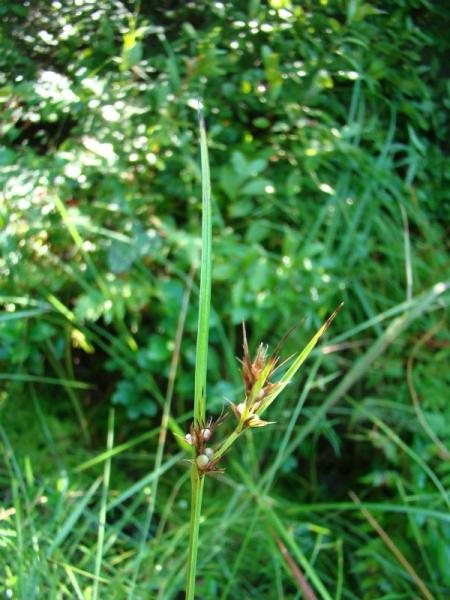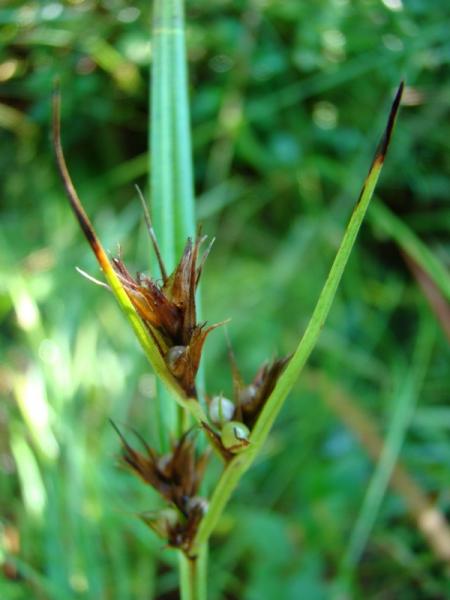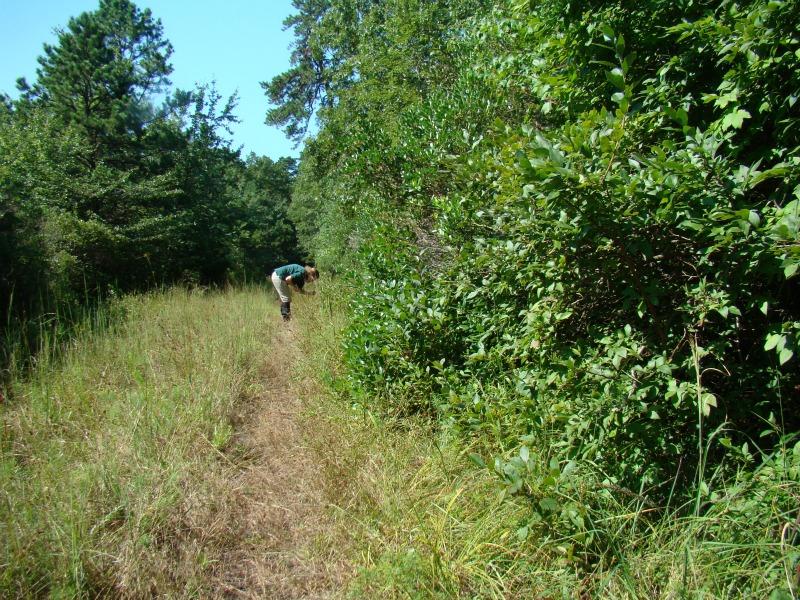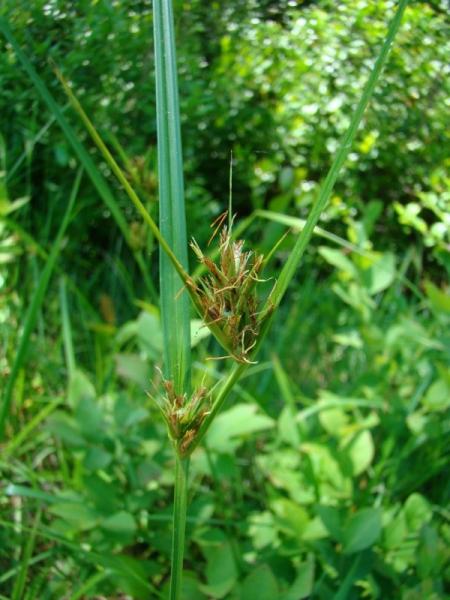Slender Nut Sedge
Scleria minor W. Stone
- Class
- Monocotyledoneae (Monocots)
- Family
- Cyperaceae (Sedge Family)
- State Protection
- Endangered
Listed as Endangered by New York State: in imminent danger of extirpation in New York. For animals, taking, importation, transportation, or possession is prohibited, except under license or permit. For plants, removal or damage without the consent of the landowner is prohibited.
- Federal Protection
- Not Listed
- State Conservation Status Rank
- S1
Critically Imperiled in New York - Especially vulnerable to disappearing from New York due to extreme rarity or other factors; typically 5 or fewer populations or locations in New York, very few individuals, very restricted range, very few remaining acres (or miles of stream), and/or very steep declines.
- Global Conservation Status Rank
- G4
Apparently Secure globally - Uncommon in the world but not rare; usually widespread, but may be rare in some parts of its range; possibly some cause for long-term concern due to declines or other factors.
Summary
Did you know?
In New York, slender nutrush was only ever known around the Islip-Oakdale area on Long Island and one wetland in Nassau County that was drained. It is presently known from the Islip area, but has not been found anywhere else on Long Island.
State Ranking Justification
There are two existing populations within a short distance of each other on Central Long Island, but neither of the populations has been seen in over 18 years. The plants may still be in the seed bank waiting for the right disturbance. This plant has always been rare in New York with only four other historical occurrences.
Short-term Trends
Existing populations have not been seen in many years and the species may be declining rapidly unless a seed bank has been established and they could return with disturbance.
Long-term Trends
This species never had more than four populations in New York so it has always been very rare. The current small populations continue that trend.
Conservation and Management
Threats
One of the populations is threatened by increased dumping and encroachment of development nearby. The succession of the wetland where it occurs is reducing habitat. The other population has plants next to a trail where they could be trampled or crowded out by the exotic Lespedeza cuneata.
Conservation Strategies and Management Practices
This species needs disturbance to reduce competition from woody plants or more aggressive herbaceous plants but too much direct disturbance to the plants will reduce or eliminate the population. Its habitat could be disturbed in the non-growing season to open it up for seed germination and colonization but direct disturbance should be prevented during the growing season.
Research Needs
Research is needed to determine if a seed bank has been established at known populations and whether disturbance would foster germination of new plants.
Habitat
Habitat
In New York, Scleria minor has only been found at acidic, wet habitats within pine barrens on Long Island (New York Natural Heritage Program 2010). Wet sandy or peaty soils in pinelands and savannas or boggy areas (FNA 2002).
Associated Ecological Communities
- Pine barrens shrub swamp
(guide)
A shrub-dominated wetland that occurs in shallow depressions in the coastal plain, often as the transition zone between a coastal plain pond shore and either pitch pine-scrub oak barrens or pitch pine-oak forest.
- Pine barrens vernal pond*
(guide)
A seasonally fluctuating pond and its associated wetlands that typically occurs in pine barrens. The water is intermittent, usually a pond in the spring but sometimes losing water through the summer to become a mostly vegetated wetland at the end of the summer. These ponds and wetlands may be small.
- Pitch pine-blueberry peat swamp*
(guide)
A swamp that occurs in shallow depressions in sand plains where peat has accumulated over a poorly drained sandy soil. This soil has a horizon cemented by iron oxide; the cemented horizon impedes drainage and causes seasonal flooding. The dominant tree is pitch pine. Gray birch and red maple are present at a low density. The canopy is open, with about 50 to 60 percent cover.
* probable association but not confirmed.
Associated Species
- Acer rubrum
- Andropogon glomeratus
- Andropogon virginicus
- Carex barrattii (Barratt's sedge)
- Juncus sp.
- Kalmia angustifolia
- Polygala lutea (orange milkwort)
- Rhynchospora capitellata (brownish beak sedge)
- Scleria triglomerata (whip nut sedge)
- Sphagnum sp.
- Woodwardia virginica
Range
New York State Distribution
This herb is currently known from Suffolk County with historical records also from Nassau County. There is an unconfirmed report from Staten Island.
Global Distribution
It extends from Long Island in the north along the Atlantic coastal plain south to South Carolina. There are also scattered populations in the mountains of North Carolina and Tennessee, the East Coast of Northern Florida and in Eastern Texas.
Identification Comments
General Description
Scleria is a genus of sedge with trigonous culms, dimorphic spikelets, and conspicuous white achenes. Slender nutrush is a perennial species, with slender stems up to 80 cm tall, rising from long rhizomes. The leaves are 1 to 2.5 mm wide and glabrous. The stems are taller and more slender than the leaves. The infloresence is subtended by leafy bracts 3 to 10 cm long, and normally consists of 1 or 2 flower clusters (fascicles) each with 1 to 5 spikelets. Only the uppermost pistillate spikelet is fertile. The fruits are brownish gray achenes, sometimes with longitudinal dark stripes, 1.5 to 2 mm long, and are covered with a whitish siliceous crust (FNA 2002).
Best Life Stage for Proper Identification
Slender nutrush is best identified when in fruit.
Similar Species
Scleria minor was once considered to be a variety of S. triglomerata. It differs from S. triglomerata by its narrower leaves (1 to 2.5 mm wide, versus 3 to 9 mm for S. triglomerata) and smaller achenes (1.5 to 2 mm wide, versus 2 to 3 mm for S. triglomerata) (FNA 2002). Both S. minor and S. triglomerata have smooth, shiny achenes, while all the other species of Scleria in New York all have rough or reticulate achenes (FNA 2002).
Best Time to See
Slender nutrush fruits from late June through the end of September.
- Fruiting
The time of year you would expect to find Slender Nut Sedge fruiting in New York.
Slender Nut Sedge Images
Images of Similar Species
Taxonomy
Slender Nut Sedge
Scleria minor W. Stone
- Kingdom Plantae
- Phylum Anthophyta
- Class Monocotyledoneae
(Monocots)
- Order Cyperales
- Family Cyperaceae (Sedge Family)
- Order Cyperales
- Class Monocotyledoneae
(Monocots)
- Phylum Anthophyta
Additional Common Names
- Nutrush
- Whipgrass
Additional Resources
Best Identification Reference
Flora of North America Editorial Committee. 2002. Flora of North America, North of Mexico. Volume 23. Magnoliophyta: Commelinidae (in part): Cyperaceae. Oxford University Press, New York. 608 pp.
Other References
Fernald, M.L. 1950. Gray's manual of botany. 8th edition. D. Van Nostrand, New York. 1632 pp.
Gleason, Henry A. and A. Cronquist. 1991. Manual of Vascular Plants of Northeastern United States and Adjacent Canada. The New York Botanical Garden, Bronx, New York. 910 pp.
Holmgren, Noel. 1998. The Illustrated Companion to Gleason and Cronquist's Manual. Illustrations of the Vascular Plants of Northeastern United States and Adjacent Canada. The New York Botanical Garden, Bronx, New York.
New York Natural Heritage Program. 2010. Biotics database. New York Natural Heritage Program. New York State Department of Environmental Conservation. Albany, NY.
New York Natural Heritage Program. 2024. New York Natural Heritage Program Databases. Albany, NY.
Weldy, T. and D. Werier. 2010. New York flora atlas. [S.M. Landry, K.N. Campbell, and L.D. Mabe (original application development), Florida Center for Community Design and Research http://www.fccdr.usf.edu/. University of South Florida http://www.usf.edu/]. New York Flora Association http://newyork.plantatlas.usf.edu/, Albany, New York
Links
About This Guide
Information for this guide was last updated on: February 28, 2011
Please cite this page as:
New York Natural Heritage Program. 2024.
Online Conservation Guide for
Scleria minor.
Available from: https://guides.nynhp.org/slender-nut-sedge/.
Accessed July 27, 2024.



